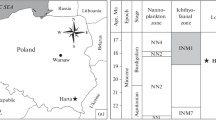Abstract
Isolated fish bones were collected in the Middle Eocene sediments extracted from the Gonglangtou mine (43°00.1′N, 126°51.4′E), near Huadian, Jilin Province, China. They mainly belong to the amiid genus Cyclurus Agassiz, 1844. Additionally, catostomids bones were also observed. They may be referred as Plesiomyxocyprinus cf. arratiae Liu and Chang, 2009. Finally, several isolated fin spines and a preoperculum bear testimony to the presence of at least one acanthomorpha and possibly of siluriforms. These fish remains are indicative of freshwater lacustrine conditions, although the fact that all the fish remains were found disarticulated results from a transportation of the bones from the living place of the fishes to the spot where the fossilisation took place.







Similar content being viewed by others
References
Beard KC, Wang BY (1991) Phylogenetic and biogeographic significance of the tarsiiform primate Asiomomys changbaicus from the Eocene of Jilin Province, People’s Republic of China. Am J Phys Anthropol 85:159–166
Boreske JR (1974) A review of the North American fossil Amiid fishes. Bull Mus Comp Zool 146(1):1–87
Bruner JC (1991) Comments on the genus Amyzon (family Catostomidae). J Paleontol 65(4):678–686
Cavender TM (1968) Freshwater fish remains from the Clarno Formation Ochoco mountains of North-Central Oregon. Ore Bin 30(7):125–141
Chang M-M, Chen G (2008) Fossil Cypriniformes from China and its adjacent areas and their palaeobiogeographical implications. In: Cavin L, Longbottom A, Richter M (eds) Fishes and the break-up of Pangaea. Geological Society Special Publications, vol 295, London, pp 337–350
Chang M-M, Miao D, Chen Y, Zhou J, Chen P (2001) Suckers (Fish, Catostomidae) from the Eocene of China account for the family’s current disjunct distributions. Sci China Ser D 44(7):577–586
Chang M-M, Wang N, Wu F-X (2010) Discovery of †Cyclurus (Amiinae, Amiidae, Amiiformes, Pisces) from China. Vertebr PalAsiat 48(2):85–100
Cope ED (1872) On the Tertiary coal and fossils of Osino, Nevada. Proc Am Philos Soc 12:478–481
Cope ED (1875) On the fishes of the Tertiary shales of the South Park. Bull US Geol Surv Territ 1(ser.2):3–5
Gaudant J (1992) “Kindleia” fragosa Jordan and “Stylomyleodon” lacus Russell: two amiid fishes from the Late Cretaceous and the Palaeocene of Alberta. Can J Earth Sci 29:158–173
Gaudant J (1999) Cyclurus kehreri (Andreae): une espèce clé pour la connaissance des Amiidae (poissons actinoptérygiens) du Paléogène européen. Cour Forsch-Inst Senckenberg 216:131–165
Grande L, Bemis WM (1998) A comprehensive phylogenetic study of Amiid fishes (Amiidae) based on comparative skeletal anatomy. An empirical search for interconnected patterns of Natural History. Society of Vertebrate Paleontology Memoir 4
Grande L, Eastman JT, Cavender TM (1982) Amyzon gosiutensis, a new catostomid fish from the Green River Formation. Copeia 1982(3):523–532
Hou LH, Ericson PGP (2002) A middle Eocene shorebird from China. Condor 104:896–899
Hussakof L (1932) The fossil fishes collected by the Central Asiatic Expedition. Am Mus Novit 553:1–10
Liu J, Chang M-M (2009) A new Eocene catostomid (Teleostei: Cypriniformes) from northeastern China and early divergence of Catostomidae. Sci China 2(D) 52:189–202
Manchester SR, Chen ZD, Geng BY et al (2005) Middle Eocene flora of Huadian, Jilin Province, Northeastern China. Acta Palaeobot 45(1):3–26
Smith GR (1992) Phylogeny and biogeography of the Catostomidae, freshwater fishes of North America and Asia. In: Mayden RL (ed) Systematics, historical ecology, and North American freswater fishes. Stanford University Press, Stanford, pp 778–826
Smith KT, Schaal SFK, Sun W, Li C-T (2011) Acrodont Iguanians (Squamata) from the Middle Eocene of the Huadian Basin of Jilin Province, China, with a critique of the taxon « Tinosaurus ». Vertebr PalAsiat 49:69–84
Suzuki K (1946) On the geological age of the so-called Mesozoic formations of Kiaoho and Hwatien, Kiri Province, Manchuria. J Geol Soc Jpn 52:613–615
Sytchevskaya EK (1986) Palaeogene freshwater fish fauna of the USSR and Mongolia. The joint Soviet-Mongolian paleontological expedition. Transactions 29:1–157
Wang BY, Li C (1990) First Paleogene mammalian fauna from northeast China (in Chinese, with English summary). Vertebr Palasiat 28(3):165–205
Wang YL, Liu ZJ, Jing HL et al (2005) Sedimentary characteristics of oil shale deposit of the Huadian formation of Paleogene in Huadian Basin (in Chinese, with English summary). J Jilin Univ (Earth Sci Ed) 35(6):720–724
Wilson MVH (1977) Middle Eocene freshwater fishes from British Columbia. Life Sci Contr R Ont Mus 113:1–61
Zhang P, Lu B, Li C et al (1986) Discovery of the Huadian fauna of the early Tertiary and its geological significance (in Chinese, with English summary). Jilin Geol 12(4):1–14
Zhou JJ, Sun JR (1985) The fossil fish fauna from the Huadian basin of the Jilin Province. Vertebr PalAsiat 23:170
Acknowledgments
We are grateful to Prof. Sun Chunlin, Prof. Sun Yuewu and Prof. Sun Ge, of the Research Center for Paleontology and Stratigraphy, Jilin University, for their promotion of this project, and to the former directors of the Gonglangtou coal mine, Liu Yan Xing and Ren Jing Ming, for allowing the collection of fossils. The project was funded by grants from the W. and E. Datz-Stiftung, the Sino-German Joint Group of Paleontology and Geosciences and by the Senckenberg Research Institute, Frankfurt am Main.
The authors wish to thank Dr. Louis P. Taverne and Dr. Norbert Micklich for their helpful suggestions and K. Smith, A. Vogel, Joël Dyon (Paris) and Christian Lemzaouda (Paris) for the production of figures and photos.
Author information
Authors and Affiliations
Corresponding author
Additional information
This article is a contribution to the special issue “Messel and the terrestrial Eocene - Proceedings of the 22nd Senckenberg Conference”
Rights and permissions
About this article
Cite this article
Gaudant, J., Schaal, S.F.K. & Wei, S. A short account on the Eocene fish fauna from Huadian (Jilin Province, China). Palaeobio Palaeoenv 92, 417–423 (2012). https://doi.org/10.1007/s12549-012-0094-4
Received:
Revised:
Accepted:
Published:
Issue Date:
DOI: https://doi.org/10.1007/s12549-012-0094-4




